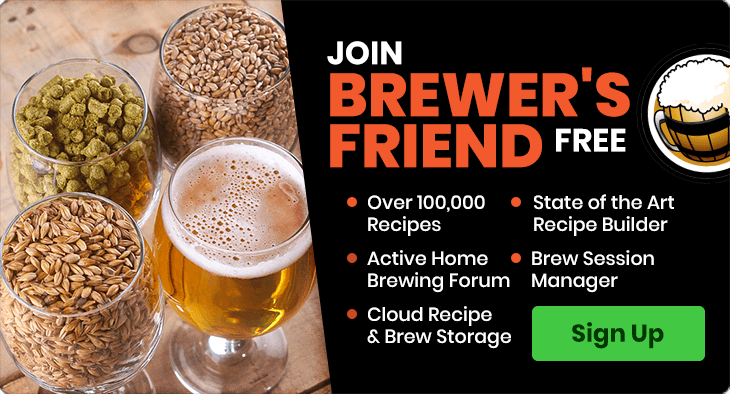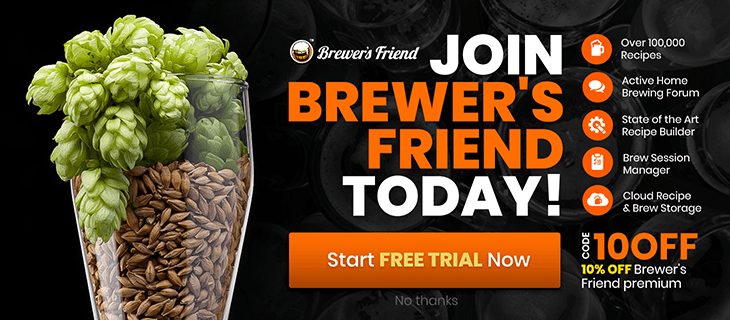Barley Wine, 2008 Recipe
Sunday, August 10th, 2008I will brew Barley Wine every spring so it is ready by winter. Next time I will try using champagne yeast a few days into the primary fermentation to get the final gravity down. Extra hops would help give it a more awesome bitter flavor. A full wort boil would also get the utilization of the hops higher. I created the IBU calculator on this site after I brewed this batch, had I checked it I would have known to add more hops. This is an expensive batch of beer and it takes a long time to ferment and age in the bottle, but it is worth waiting for. It is not a beer you can drink a lot of in one setting. It is more of a beer you drink from a snifter to finish off the night.
| Target Volume (Gallons) | 6 | |||
| Total Cost | $62.55 | |||
| Yield (ounces) | 712 | |||
| Cost per 12 oz bottle | $1.05 | |||
| Boil Time | 90 | min | ||
| GRAINS | Pounds | Points/Gal | Total Points | Cost |
| Light LME | 16.7 | 37 | 617.9 | $32.57 |
| Honey, stonewood hallelujah | 0.05 | 35 | 1.75 | $0.00 |
| Dark DME | 1 | 45 | 45 | $3.85 |
| Steep – 40 min at 150 F | ||||
| Crystal 20 | 1 | 28 | 28 | $1.00 |
| Crystal 80 | 1 | 28 | 28 | $1.00 |
| Chocolate | 0.25 | 28 | 7 | $0.25 |
| Special B | 0.25 | 28 | 7 | $0.45 |
| HOPS | Ounces | Alpha Acids | Boil Time (min) | Cost |
| Domestic Magnum | 2 | 14.90% | 90 | $4.00 |
| Amarillo | 1 | 9.60% | 60 | $4.00 |
| Amarillo | 1 | 9.60% | 10 | |
| Centennial | 2 | 9.30% | 10 | $4.50 |
| Yamhill Goldings | 1 | dry hop secondary | $2.00 | |
| YEAST | White Labs California Ale | Cost | ||
| Attenuation Low | 73% | $6.58 | ||
| Attenuation High | 80% | |||
| Optimum Temp | 68-73 F | |||
| Flocculation | Medium | |||
| Starter | No | |||
| STATS | ||||
| Expected Original Gravity | 1.122 | |||
| Expected Final Gravity | 1.024 – 1.03 | |||
| IBUs | 52.31 | |||
| Apparent Attenuation | 68.18% | AA = 1 – FG / OG | ||
| Alcohol By Volume – Theoretical | 11.48% | |||
| Alcohol By Volume – Potential | 9.84% | |||
| BREWING: | Squeezed out hops bags thoroughly | |||
| ½ tbs Irish Moss at start of boil | $0.10 | |||
| Water Source Wort | Pure water filter – 3 gallon boil | |||
| Water Source Dilution | Pure water filter | |||
| DATES | Date | SG | Cum. Days | Notes |
| Brewed | 05/08/08 | 1.110 | 0 | |
| Racked | 05/19/08 | 1.050 | 11 | Smelled honey in the yeast, yummy |
| Dry Hopped | 05/26/08 | 1.038 | 18 | 1 oz Yamhill Goldings, loose |
| SG Sample | 05/28/08 | 1.038 | 20 | Lots of yeast particles floating still |
| Racked II | 06/01/08 | 1.036 | 24 | Tastes great! still a bit syrupy, excellent complex bitter finish |
| Bottled (SG pre bottling) | 06/07/08 | 1.035 | 30 | |
| OK TO DRINK BY (180 days): | 11/04/08 | |||
| BOTTLING | ||||
| Priming Method | 6.5 oz Corn Syrup | $0.50 | ||
| Caps, cleaners, etc | $1.75 | |||
| Container | Capacity | Qty | Total Volume | |
| Bottle | 12 | 54 | 648 | |
| Jug | 64 | 1 | 64 | |
| Total Bottled: | 712 | |||
| TASTING | Date | Days | ||
| 06/22/08 | 45 | No carbonation or head, excellent malty flavor, not as bitter as I would like, the goldings really comes out and the spices from the Amarillo hops are nice. | ||
| 08/15/08 | 99 | Not as bitter as before, chocolaty and a little sweet rich malty flavor. | ||
| Creamy in the mouth, with a complex hop finish. | ||||






